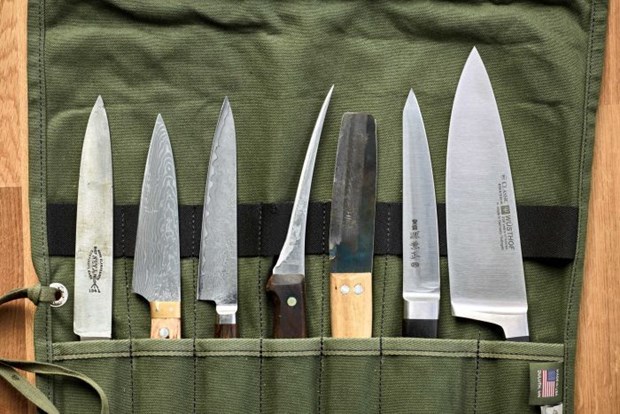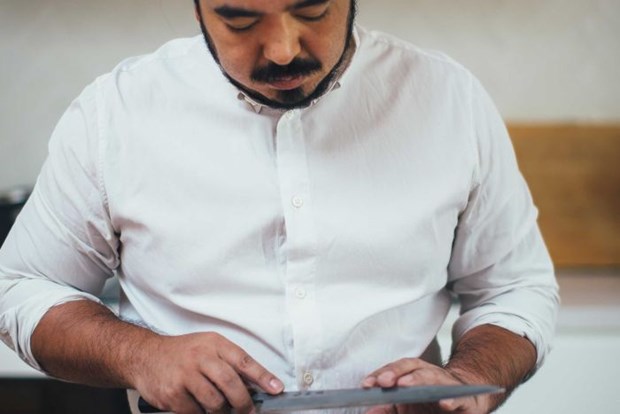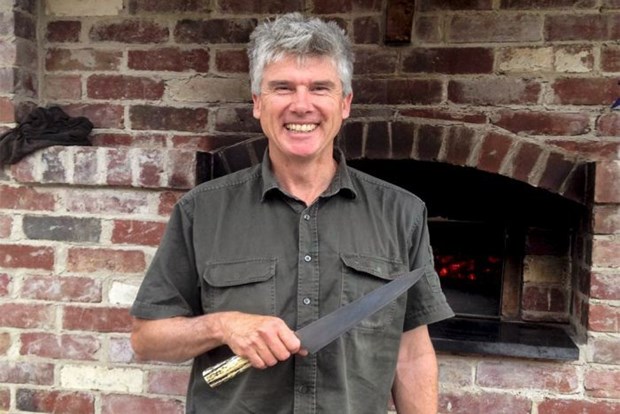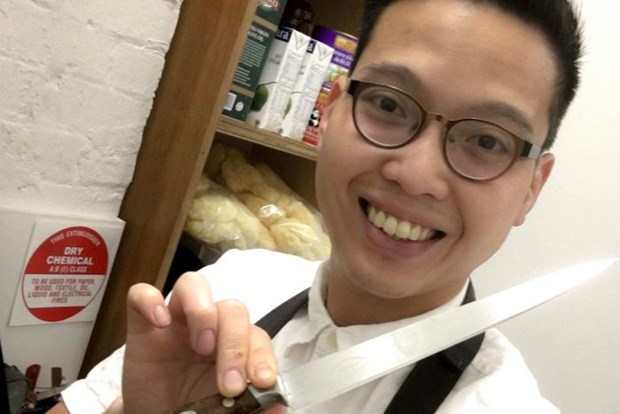"There is no object you own that is anything like your kitchen knife," writes British food writer and author Tim Hayward.

A whole culture has sprung up around the humble chef's knife. (Supplied: Hardie Grant Publishing)
"Think
about it—eight inches of lethally sharp, weapons grade metal lying on your
kitchen table, possessing the same potential for mayhem as a loaded handgun—and
yet it is predominantly used to express your love for your family by making
their tea."
The
intricate and diverse world of the knife is something that Hayward has explored
in his latest book, Knife: The Culture, Craft and Cult of the Cook's Knife.
From
his grandmother's humble breadknife to a 47-word glossary of Japanese knife
terms, Hayward celebrates knives and the culture that surrounds them.
In
response, RN asked some prominent chefs to nominate their favourite knife.
Adam Liaw, 2010
Masterchef winner

Adam Liaw holds his favourite knife, a simple Japanese yanagiba, which he uses to cut sashimi. (Supplied: Adam Liaw)
It's
genuinely hard to pick a favourite knife, I've probably got about 30 or 40
different knives ranging from cheap $2-$3 ones that I've just bought for a
particular job or a particular purpose, through to my most expensive, which was
about $1,500.
That
was handmade for me by one of the really old samurai sword manufacturers in
Japan.
But
I guess my favourite is the one I enjoy cutting with the most and that is a
fairly simple Japanese yanagiba made by another Japanese knifemaker.
It
wasn't hugely expensive, only about $400 or so, but I use it an awful lot for
cutting sashimi.
I
enjoy cutting with it—it's got a really good balance, it fits the way I move
with the knife, fits my style of cooking. Also it makes a very simple meal,
which is just cut-up raw fish, into a bit of a theatre or a meditation.
You
enjoy it a bit more, rather than trying to be frantic about your cutting and
your preparation.
Matthew Evans, owner
of Fat Pig Farm, Huon Valley, Tasmania

Matthew Evans had to wait for 15 years to get his dream knife. (Supplied)
I
waited about 15 years to get this knife, as the maker decides on who the knife
suits only after it's been forged, and mine took a while to craft.
It's
made from hand-forged Damascus steel, by legendary Tasmanian John
Hounslow-Robinson, out of an old saw blade. The sheath is reclaimed Huon pine,
and the handle is deer antler.
The
whole thing is a work of art. Holding it, you can feel the energy of the
blacksmith's pounding of the steel.
The
other special thing is that it was given to me by my gorgeous partner, Sadie:
one of the most thoughtful gifts imaginable.
Victor Liong, chef
and owner of Lee Ho Fook, Melbourne

At first, Haru Inukai told Victor Liong he wasn't ready for a Nenox slicer. (Supplied) At first, Haru Inukai told Victor Liong he wasn't ready for a Nenox slicer. (Supplied)
When
I worked at Galileo [at the Observatory Hotel in Sydney] in my second year of
my apprenticeship I worked with a lot of Japanese chefs.
Haru
Inukai was my executive chef at the time, and the funny thing about that
kitchen was that everyone was working with a slicer, which is kind of like a
sushi knife but double-sided not single-sided.
I
thought that was the coolest thing; they were using it as a paring knife, like
a chef's knife.
When
I found that Haru had this particular brand, Nenox, I asked him where he got it
from. At the time there was only a small shop in Tokyo that had it and I asked
him to get one for me.
His
first response was: "No, you are not ready."
After
the first year I asked again and he said, "Yes, I will get one for
you." I got the basic, basic model with a black handle, and I cherished
that for a year.
Then
one of the boys went back to Japan towards the end of my time with him and I
was like, "Hey, can you get me the S1?" The S1 is this knife here.
It's
got a Chinese quince wood handle and it is an exceptionally light and dexterous
little knife. He got my name engraved in it and I have had it ever since.
Nicky Riemer, chef
and co-owner of Union Dining, Melbourne

Nicky Riemer says the Shun is her favourite boning knife. (Supplied)
This
is probably my favourite boning knife. It is not a very attractive name—it's
not a sashimi knife or anything—but it serves an amazing purpose. I probably
use it every day in the kitchen.
The
style of cooking I do requires the breaking down of whole fish and whole birds.
I
love it because it has a great shape and because it is easy to keep sharp, and
when you're deboning an entire fish or an entire quail you need something that
you feel is just like another part of your hand.
I've
been cooking for about 23 years and I have got knives still at home from when I
first started. I've got knives that I bought that were expensive that I hated.
Over
the years I've spent a bit of money, probably all chefs have, and then you find
there are knives that you just love.
I've
actually got a boning knife from when I started my apprenticeship. I think it's
almost like a toothpick, I've sharpened it that many times over that many
years.
It
doesn't really do much, but it's just there for me to remember that it was one
of my first knives.
By Catherine Pryor/abc.net